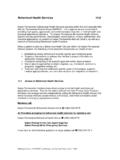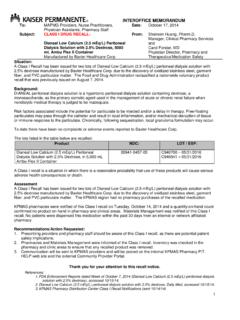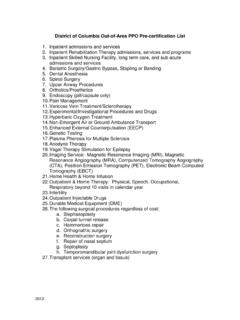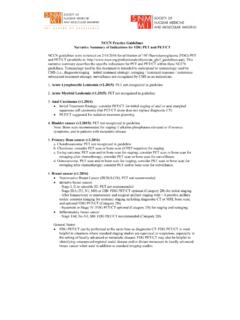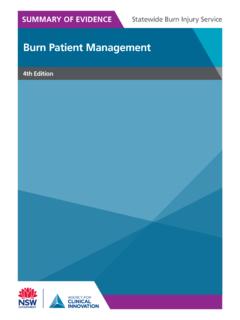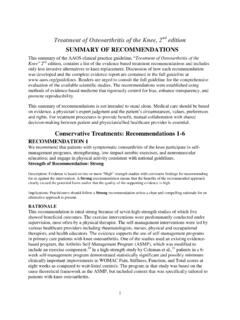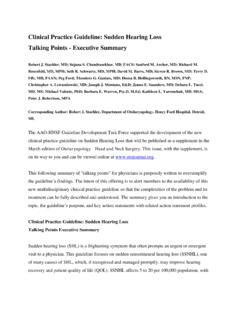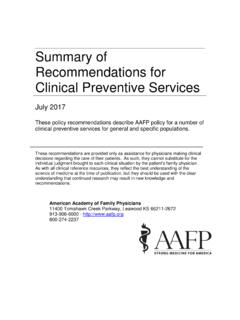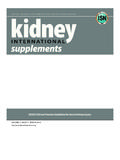Transcription of Osteoporosis/Fracture Prevention Clinical Practice ...
1 NATIONAL Clinical Practice GUIDELINE Osteoporosis/Fracture Prevention Clinical Practice Guideline summary This guideline is informational only. It is not intended or designed as a substitute for the reasonable exercise of independent Clinical judgment by practitioners, considering each patient s needs on an individual basis. Guideline recommendations apply to populations of patients. Clinical judgment is necessary to design treatment plans for individual patients. Approved by the National Guideline Directors November 2010 Guideline This guideline is informational only. It is not intended or designed as a substitute for the reasonable exercise of independent Clinical judgment by practitioners, considering each patient s needs on an individual basis. Guideline recommendations apply to populations of patients. Clinical judgment is necessary to design treatment plans for individual patients.
2 The guidelines summary is organized as follows: I. Screening with Dual Energy X-Ray Absorptiometry (DXA) II. Bone Mineral Density (BMD) Measurement Sites III. Absolute fracture Risk IV. Nonpharmacologic Interventions V. Screening for Vitamin D Deficiency VI. Dietary and Pharmacologic Interventions VII. Monitoring Treatment 2010 Kaiser Permanente Medical Care Program 1 For use within Kaiser Permanente only. 11/10 National osteoporosis fracture Prevention Clincial Practice Guideline I. Screening with Dual Energy X-Ray Absorptiometry (DXA) Postmenopausal Women 1A. A bone mineral density (BMD) test by DXA is recommended for postmenopausal women aged 65 or older who are not on drug treatment for osteoporosis . Evidence-based: B 1B. For postmenopausal women under age 65, a BMD test by DXA is an option when selected risk factors are present.
3 Consensus-based NOTE: In addition to advancing age and female sex, risk factors in the FRAX* model include low body mass index (BMI), personal history of fragility fracture after age 50, parental history of hip fracture , rheumatoid arthritis, long-term exposure to systemic corticosteroids (3 months or more at doses 5 mg), high alcohol intake (about 3 ounces per day), cigarette smoking, and other causes of secondary osteoporosis ( , type 1 diabetes, osteogenesis imperfecta in adults, untreated long-standing hyperthyroidism, hypogonadism or premature menopause (< 45 years), chronic malnutrition, or malabsorption and chronic liver disease). It is useful to review the FRAX model and risk factors with patients. 1C. For individuals under age 65 who are at high risk, such as those with a prior fragility fracture after age 50 or glucocorticoid use for 3 months or more at doses 5 mg, refer to the fracture Risk Assessment Tool (FRAX) to estimate individual fracture risk.
4 Consensus-based Premenopausal Women: 1D. Routine screening for osteoporosis with a BMD test by DXA is not recommended for premenopausal women. Consensus-based Men: 1E. Screening with DXA is an option for men aged 70 or older with risk factors. Consensus-based * FRAX risk charts can be accessed on the FRAX web site: ( ). 2010 Kaiser Permanente Medical Care Program 2 For use within Kaiser Permanente only. 11/10 National osteoporosis fracture Prevention Clincial Practice Guideline Optimal screening frequency: 1F. The recommended retesting interval for women not currently on treatment is 5 years. Varying the interval is an option in the presence or absence of risk factors. Consensus-based NOTE: For a healthy 50-year-old woman with a T-score of , it may take 10 to 20 years to drop to a T-score of II. Bone Mineral Density (BMD) Measurement Sites 2A.
5 When BMD testing is indicated, the total proximal femur (total hip), femoral neck, and lumbar spine are recommended measurement sites for DXA to predict risk of osteoporotic fracture in women and men. Evidence-based: B 2B. The lowest T-score from the measurements of the total hip, femoral neck, and lumbar spine (L1 to L4, composite score) is recommended to establish a diagnosis of osteoporosis (T-score ) or low BMD (T-score between and ). Consensus-based 2C. DXA of the forearm (distal one-third of the radius) is an option for patients in whom hip and spine BMD cannot be measured or interpreted. Evidence-based: B III. Absolute fracture Risk 3A. The fracture Risk Assessment Tool (FRAX*) is strongly recommended for assessing absolute fracture risk in women or men before initiation of treatment. Evidence-based: A NOTE: FRAX is not designed to assess fracture risk in patients on bisphosphonate treatment.
6 3B. Pharmacologic treatment for osteoporosis in women or men is recommended when the 10-year probability of hip fracture reaches 3%. Consensus-based 3C. Pharmacologic treatment for osteoporosis in women or men is optional when the 10-year probability of hip fracture is < 3%. Consensus-based NOTE: The safety and efficacy of long-term use of bisphosphonates for more than 5 to 10 years are uncertain; therefore, the decision to start open-ended treatment in younger patients should be considered carefully. * FRAX risk charts can be accessed on the FRAX web site: ( ). 2010 Kaiser Permanente Medical Care Program 3 For use within Kaiser Permanente only. 11/10 National osteoporosis fracture Prevention Clincial Practice Guideline IV. Nonpharmacologic Interventions 4A. The following lifestyle changes are recommended for all adults: Exercise regular weight-bearing and muscle-building exercise Smoking cessation Consensus-based 4B.
7 Home safety proofing is recommended for postmenopausal women and men at risk of falling. Consensus-based NOTE: Home safety proofing includes removing rugs, adding grab bars, establishing adequate lighting ( , nightlights), and securing electrical cord placement. 4C. The routine use of hip protectors is not recommended as an intervention for reducing the risk of hip fractures in postmenopausal women and men aged 50 or older. Evidence-based: D V. Screening for Vitamin D Deficiency 5A. Screening for vitamin D deficiency is not recommended for identifying vitamin D deficiency in adults aged 50 years or older without osteoporosis . Consensus-based 5B. Testing for vitamin D deficiency and supplementation with vitamin D to an acceptable level of 30 ng/ml before initiating bisphosphonate therapy is recommended. Consensus-based 2010 Kaiser Permanente Medical Care Program 4 For use within Kaiser Permanente only.
8 11/10 National osteoporosis fracture Prevention Clincial Practice Guideline VI. Dietary and Pharmacologic Interventions Preventive measures for all women and men: 6A. Total daily intake of calcium is recommended for all pre- or postmenopausal women and older men (1,000 mg/day for premenopausal women; 1,200 mg/day for postmenopausal women and men aged 50 or older). Many individuals require supplemental calcium therapy. Evidence-based: B 6B. Total daily intake of vitamin D (at least 1,000 IU/day), preferably vitamin D3, is recommended for all pre- or postmenopausal women and men aged 50 or older. Consensus-based NOTE: Calcium carbonate contains the most elemental calcium per dose. It should be taken with food to enhance absorption. Calcium citrate contains less elemental calcium than the carbonate salt, but it is better absorbed and may be preferred in patients with reduced gastric acid production or high gastric pH requiring long-term H2 antagonist or proton pump inhibitor therapy and in patients who have undergone bariatric surgery.
9 It is more expensive and usually requires more tablets to be taken per day than calcium carbonate. Preventive measures for women and men without osteoporosis : 6C. Hormone therapy solely for the Prevention of osteoporosis is not recommended. Consensus-based Treatment for postmenopausal women diagnosed with osteoporosis : FIRST-LINE DRUG THERAPY: 6D. Alendronate (10 mg/day or 70 mg/week) is recommended as a first-line therapy for: Postmenopausal women with a prior fragility fracture . Evidence-based: A Women aged 65 or older with a diagnosis of osteoporosis (T-score ). Evidence-based: A Postmenopausal women with a FRAX* 10-year risk of hip fracture 3%. Consensus-based Alendronate is an option for postmenopausal women under the age of 65 diagnosed with osteoporosis (T-score ), but without a FRAX 10-year risk of hip fracture 3%. Consensus-based * FRAX risk charts can be accessed on the FRAX web site: ( ).
10 2010 Kaiser Permanente Medical Care Program 5 For use within Kaiser Permanente only. 11/10 National osteoporosis fracture Prevention Clincial Practice Guideline 6E. Risedronate (5 mg/day or 35 mg/week) is a recommended alternative to alendronate for the categories of patients described in 6D. Evidence-based: A NOTE: Bisphosphonates are not recommended in women of childbearing age without adequate contraception. Bisphosphonates should be used with caution in patients with chronic kidney disease and reduced glomerular filtration rate. Screening for vitamin D deficiency and supplementation with vitamin D to an acceptable level of > 30 ng/ml before initiating bisphosphonate therapy is recommended. (See Recommendation 5B: Consensus-based) The major determinant of fracture risk reduction with bisphosphonate therapy is continuing to take the therapy. Short-term interruption of bisphosphonates is not associated with rapidly rising risk of fracture .
